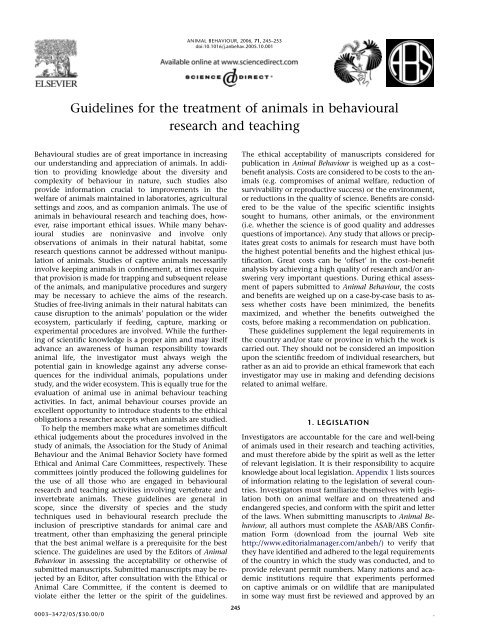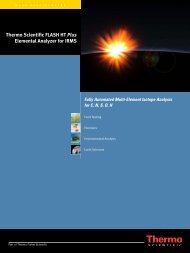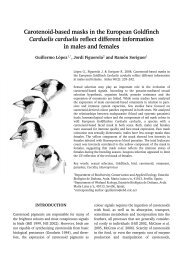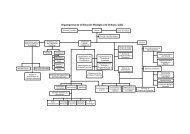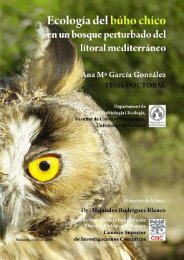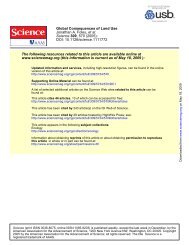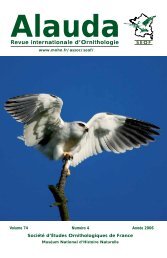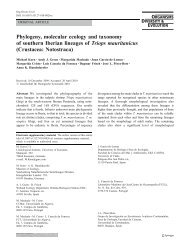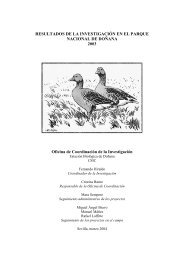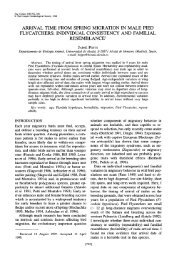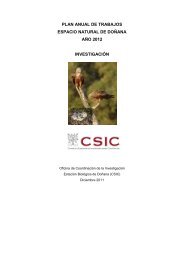Guidelines for the Treatment of Animals in Research and Teaching
Guidelines for the Treatment of Animals in Research and Teaching
Guidelines for the Treatment of Animals in Research and Teaching
Create successful ePaper yourself
Turn your PDF publications into a flip-book with our unique Google optimized e-Paper software.
246ANIMAL BEHAVIOUR, 71, 1animal welfare, animal care <strong>and</strong> use, or ethics committee<strong>of</strong> <strong>the</strong> sponsor<strong>in</strong>g <strong>in</strong>stitution (Jenn<strong>in</strong>gs 1994; Hagel<strong>in</strong>et al. 2003). It is recommended that <strong>in</strong>vestigators fromcountries without any legal requirements or guidel<strong>in</strong>esvoluntarily refer to one or more <strong>of</strong> <strong>the</strong> documents <strong>in</strong> Appendix1 <strong>for</strong> guidance. A manuscript based on <strong>in</strong>stitutionalcommittee-approved research may still be referred byeditors or reviewers to <strong>the</strong> Ethical <strong>and</strong> Animal Care Committees<strong>of</strong> ASAB/ABS, if <strong>the</strong>y feel <strong>the</strong> manuscript raisesethical concerns.2. THE THREE R’S: REPLACEMENT, REDUCTIONAND REFINEMENTMuch <strong>of</strong> <strong>the</strong> current recommendations <strong>and</strong> legislation <strong>for</strong>ensur<strong>in</strong>g appropriate animal care <strong>and</strong> use are based on <strong>the</strong>three guid<strong>in</strong>g pr<strong>in</strong>ciples <strong>of</strong> replacement, reduction <strong>and</strong>ref<strong>in</strong>ement (Russell & Burch 1959). Replacement refers toef<strong>for</strong>ts to replace animal subjects <strong>and</strong> models with nonanimalones, such as tissue cultures or computer models,wherever it is possible to do so while still achiev<strong>in</strong>g <strong>the</strong> scientificobjectives. Reduction means reduc<strong>in</strong>g <strong>the</strong> numbers<strong>of</strong> animals affected by <strong>the</strong> experiment to <strong>the</strong> lowest number<strong>of</strong> <strong>in</strong>dividuals necessary to achieve <strong>the</strong> aims <strong>of</strong> <strong>the</strong> experiment<strong>and</strong> statistical power. There will be occasionswhen it is possible to reduce <strong>the</strong> total number <strong>of</strong> animalsused <strong>in</strong> an experiment, but only by <strong>in</strong>creas<strong>in</strong>g <strong>the</strong> degreeor duration <strong>of</strong> discom<strong>for</strong>t <strong>for</strong> <strong>the</strong> fewer <strong>in</strong>dividuals that areused. In such cases, <strong>the</strong> <strong>in</strong>vestigator must f<strong>in</strong>d an ethicalbalance between <strong>the</strong> two pr<strong>in</strong>ciples, <strong>and</strong> decide whichproduces <strong>the</strong> least ethical harm. Ref<strong>in</strong>ement refers to ef<strong>for</strong>tsto design <strong>and</strong> conduct <strong>the</strong> study as carefully as possibleto maximize <strong>the</strong> scientific benefit while m<strong>in</strong>imiz<strong>in</strong>gsuffer<strong>in</strong>g to <strong>the</strong> animals, <strong>for</strong> example by plann<strong>in</strong>g <strong>and</strong> implementation<strong>of</strong> humane endpo<strong>in</strong>ts <strong>in</strong> <strong>the</strong> event thatproblems arise (Richmond 1998; Rowan 1998).3. CHOICE OF SPECIES AND NONANIMALALTERNATIVESInvestigators should choose species <strong>and</strong> stra<strong>in</strong>s <strong>for</strong> studythat are appropriate <strong>and</strong> best suited <strong>for</strong> <strong>in</strong>vestigation <strong>of</strong><strong>the</strong> questions posed. Choos<strong>in</strong>g <strong>the</strong>se requires knowledge<strong>of</strong> natural history <strong>and</strong> phylogenetic relationships. Knowledge<strong>of</strong> an <strong>in</strong>dividual animal’s previous experience, suchas whe<strong>the</strong>r or not it has spent a lifetime <strong>in</strong> captivity, is alsoimportant. Recent advances <strong>in</strong> genetic characterization <strong>of</strong>many laboratory animals may also allow <strong>the</strong> <strong>in</strong>vestigatorto control <strong>for</strong> <strong>the</strong> effects <strong>of</strong> genotype on expectedbehavioural traits. The specialist characteristics <strong>and</strong> needs<strong>of</strong> some genetically altered stra<strong>in</strong>s must also be considered(Rob<strong>in</strong>son et al. 2003); <strong>the</strong>se are becom<strong>in</strong>g <strong>in</strong>creas<strong>in</strong>glycommon <strong>in</strong> behavioural studies <strong>and</strong> <strong>the</strong>ir welfare status<strong>and</strong> responses can be considerably different to those <strong>of</strong>nonmodified animals. When research or teach<strong>in</strong>g <strong>in</strong>volvesprocedures or hous<strong>in</strong>g conditions that may causepa<strong>in</strong>, discom<strong>for</strong>t or stress to <strong>the</strong> animal, <strong>and</strong> when alternativespecies or stra<strong>in</strong>s can be used, <strong>the</strong> researcher shoulduse <strong>the</strong> species or stra<strong>in</strong> that is believed to be <strong>the</strong> least likelyto experience pa<strong>in</strong> or distress (OTA 1986). The fact thata species be<strong>in</strong>g studied is classified as ‘verm<strong>in</strong>’ <strong>in</strong> <strong>the</strong> countryconcerned does not free <strong>the</strong> researcher from normalobligations to <strong>the</strong> experimental animals. The majority <strong>of</strong><strong>in</strong>vertebrate species are usually excluded from legislationregulat<strong>in</strong>g scientific research on animals. This does notmean that <strong>the</strong>y are all unable to experience pa<strong>in</strong>, discom<strong>for</strong>tor stress (Sherw<strong>in</strong> 2001). Manuscripts <strong>in</strong>volv<strong>in</strong>g researchwith <strong>in</strong>vertebrates may still be reviewed by <strong>the</strong>Ethical <strong>and</strong> Animal Care Committees <strong>in</strong> light <strong>of</strong> <strong>the</strong>most current knowledge <strong>in</strong> this respect. <strong>Research</strong>ers us<strong>in</strong>gsuch species should seek expert advice <strong>and</strong> take any evidenceon this matter relat<strong>in</strong>g to <strong>the</strong>ir species <strong>in</strong>to accountwhen design<strong>in</strong>g experiments, <strong>and</strong> should endeavour tom<strong>in</strong>imize potential harm wherever possible. Live animalsubjects are generally essential <strong>in</strong> behavioural research,but nonanimal alternatives such as video records fromprevious work or computer simulations can sometimesbe used (Smyth 1978; van Zutphen & Balls 1997). Material<strong>of</strong> this k<strong>in</strong>d also exists or can be produced <strong>for</strong> teach<strong>in</strong>gpurposes <strong>and</strong> can sometimes be used <strong>in</strong>stead <strong>of</strong> live animalsto teach aspects <strong>of</strong> <strong>the</strong> behavioural sciences (v<strong>and</strong>er Valk et al. 1999; Smith & Smith 2001).4. NUMBER OF INDIVIDUALSThe researcher should use <strong>the</strong> smallest number <strong>of</strong> animalsnecessary <strong>and</strong> sufficient to accomplish <strong>the</strong> research goals,especially <strong>in</strong> studies that <strong>in</strong>volve manipulations that arepotentially detrimental to <strong>the</strong> animal or <strong>the</strong> population.The number <strong>of</strong> animals used <strong>in</strong> an experiment can <strong>of</strong>tenbe dramatically reduced by pilot studies, good experimentaldesign <strong>and</strong> <strong>the</strong> use <strong>of</strong> statistical tests that enable severalfactors to be exam<strong>in</strong>ed simultaneously (Weigler 1995;Fest<strong>in</strong>g 2001). Hunt (1980), Still (1982) <strong>and</strong> McConway(1992) discuss ways <strong>of</strong> m<strong>in</strong>imiz<strong>in</strong>g <strong>the</strong> numbers <strong>of</strong> animalsused <strong>in</strong> experiments while reta<strong>in</strong><strong>in</strong>g scientific validitythrough sound experimental design <strong>and</strong> dataanalysis. It is equally important not to use so few animalsthat <strong>the</strong> value <strong>of</strong> <strong>the</strong> research is compromised. Useful referenceworks are Cox (1958) <strong>and</strong> Cochran & Cox (1966).Investigators should be aware that <strong>in</strong> studies <strong>in</strong>volv<strong>in</strong>g<strong>the</strong> use <strong>of</strong> genetically altered animals, <strong>the</strong>re may beunderly<strong>in</strong>g ethical <strong>and</strong> welfare problems associated with<strong>the</strong>ir use, <strong>in</strong>clud<strong>in</strong>g <strong>the</strong> fact that greater numbers <strong>of</strong>animals are used <strong>in</strong> <strong>the</strong> pre-experimental productionphase <strong>of</strong> <strong>the</strong>se animals. There are published discussions<strong>of</strong> <strong>the</strong> pros <strong>and</strong> cons <strong>of</strong> us<strong>in</strong>g genetically altered animals(Hubrecht 1995; Poole 1995; Wolf & Wanke 1997; BoydGroup 1999).5. PROCEDURESInvestigators are encouraged to discuss with colleaguesboth <strong>the</strong> scientific value <strong>of</strong> <strong>the</strong>ir research proposals <strong>and</strong>possible animal welfare <strong>and</strong> ethical considerations. Thereare several models <strong>for</strong> evaluat<strong>in</strong>g animal research that
248ANIMAL BEHAVIOUR, 71, 1field studies <strong>of</strong> natural encounters should be used <strong>in</strong> preferenceto staged encounters. Where staged encounters arenecessary, <strong>the</strong> use <strong>of</strong> models or video/film playback shouldbe considered, <strong>the</strong> number <strong>of</strong> animals should be kept to <strong>the</strong>m<strong>in</strong>imum needed to accomplish <strong>the</strong> experimental goals,<strong>and</strong> <strong>the</strong> experiments made as short as possible. Suffer<strong>in</strong>gcan also be reduced by cont<strong>in</strong>uous observation with <strong>in</strong>terventionto stop aggression at predef<strong>in</strong>ed levels, <strong>and</strong> by provid<strong>in</strong>gprotective barriers <strong>and</strong> escape routes <strong>for</strong> <strong>the</strong> subjects.(c) Aversive Stimulation <strong>and</strong> Deprivationas Motivational ProceduresAversive stimulation, deprivation or restriction <strong>of</strong> resourcescan cause pa<strong>in</strong> or distress to animals. To m<strong>in</strong>imizesuffer<strong>in</strong>g, <strong>the</strong> <strong>in</strong>vestigator should <strong>in</strong>vestigate whe<strong>the</strong>r<strong>the</strong>re is an alternative reward strategy that could be usedto motivate <strong>the</strong> animal <strong>in</strong> <strong>the</strong> study. If an alternativereward strategy is unavailable or <strong>the</strong> effect <strong>of</strong> aversivestimulation is itself <strong>of</strong> <strong>in</strong>terest (e.g. <strong>in</strong> studies <strong>of</strong> fear, stressor pa<strong>in</strong>), <strong>in</strong>vestigators should ensure that <strong>the</strong> levels <strong>of</strong>restriction, deprivation or aversive stimulation used are nogreater than necessary to achieve <strong>the</strong> goals <strong>of</strong> <strong>the</strong> experiment.Alternatives to aversive stimuli <strong>and</strong> deprivationstrategies <strong>in</strong>clude <strong>the</strong> use <strong>of</strong> highly preferred foods <strong>and</strong>o<strong>the</strong>r rewards that may motivate even satiated animals(Re<strong>in</strong>hardt 1997; Laule 1999; Gr<strong>and</strong><strong>in</strong> 2000). Use <strong>of</strong> m<strong>in</strong>imalaversive stimuli levels requires knowledge <strong>of</strong> <strong>the</strong>technical literature <strong>in</strong> <strong>the</strong> relevant area: quantitative studies<strong>of</strong> aversive stimulation are reviewed by Church (1971)<strong>and</strong> Rushen (1986), <strong>and</strong> <strong>the</strong> behaviour <strong>of</strong> satiated animalsis considered by Morgan (1974). Be<strong>for</strong>e decid<strong>in</strong>g <strong>in</strong> favour<strong>of</strong> aversion or deprivation, <strong>in</strong>vestigators should considerconsult<strong>in</strong>g with animal care staff, laboratory animal scientists<strong>and</strong> veter<strong>in</strong>ary surgeons experienced <strong>in</strong> work<strong>in</strong>g withanimals <strong>in</strong> research sett<strong>in</strong>gs. Practical animal motivation<strong>and</strong> tra<strong>in</strong><strong>in</strong>g is a highly specialized skill. The failure <strong>of</strong> positivere<strong>in</strong><strong>for</strong>cement methods to motivate an animal mayreflect only <strong>the</strong> strategy or tactic used, <strong>the</strong> skill <strong>of</strong> <strong>the</strong> researchstaff <strong>and</strong> level <strong>of</strong> rapport with <strong>the</strong> animal. It doesnot necessarily <strong>in</strong>dicate that it would be impossible <strong>for</strong>a skilled tra<strong>in</strong>er to motivate <strong>the</strong> animal successfully withpositive re<strong>in</strong><strong>for</strong>cement methods. Fur<strong>the</strong>r comments on reduc<strong>in</strong>gdistress caused by motivational procedures are tobe found <strong>in</strong> Lea (1979) <strong>and</strong> Moran (1975).(d) Social Deprivation, Isolation<strong>and</strong> Crowd<strong>in</strong>gExperimental designs that require keep<strong>in</strong>g animals <strong>in</strong>overcrowded conditions, or that <strong>in</strong>volve social disruption,deprivation or isolation, may be extremely stressful to <strong>the</strong>animals <strong>in</strong>volved, <strong>and</strong> may adversely impact <strong>the</strong> behavioursbe<strong>in</strong>g studied. Because <strong>the</strong> degree <strong>of</strong> stress experiencedby <strong>the</strong> <strong>in</strong>dividual animal can vary with species, age,sex, reproductive condition, developmental history <strong>and</strong>social status, <strong>the</strong> natural social behaviour <strong>of</strong> <strong>the</strong> animalsconcerned <strong>and</strong> <strong>the</strong>ir previous social experience must beconsidered to m<strong>in</strong>imize such stress (Shepherdson et al.1998; Poole & Dawk<strong>in</strong>s 1999).(e) Deleterious ConditionsStudies aimed at <strong>in</strong>duc<strong>in</strong>g deleterious conditions <strong>in</strong>animals are sometimes per<strong>for</strong>med to ga<strong>in</strong> scientific knowledge<strong>of</strong> value to human or animal problems. Suchconditions <strong>in</strong>clude <strong>in</strong>duc<strong>in</strong>g disease, <strong>in</strong>creas<strong>in</strong>g parasiteloads, <strong>and</strong> expos<strong>in</strong>g animals to pesticides or o<strong>the</strong>r environmentalstressors. Special care should be taken <strong>in</strong>studies <strong>in</strong>volv<strong>in</strong>g genetically altered animals (e.g. transgenicanimals or those with <strong>in</strong>duced mutations), becausesuch modifications may compromise welfare even if this isnot <strong>the</strong> primary goal <strong>of</strong> <strong>the</strong> modification. Geneticallyaltered animals should be checked or screened <strong>for</strong> possiblewelfare problems <strong>and</strong> <strong>the</strong>ir suitability as <strong>the</strong> most appropriatespecies/stra<strong>in</strong> carefully considered. Studies <strong>in</strong>duc<strong>in</strong>ga deleterious condition <strong>in</strong> animals should address <strong>the</strong>possible treatment or alleviation <strong>of</strong> <strong>the</strong> condition <strong>in</strong>duced.<strong>Animals</strong> exposed to deleterious conditions that mightresult <strong>in</strong> suffer<strong>in</strong>g or death should be monitored frequentlyus<strong>in</strong>g appropriately sensitive methods. Such methods may<strong>in</strong>volve <strong>the</strong> use <strong>of</strong> behavioural <strong>in</strong>dicators <strong>of</strong> harm or teststhat predict <strong>the</strong> development <strong>of</strong> serious states <strong>of</strong> harm,such as impend<strong>in</strong>g organ failure. Investigators are urged toseek <strong>the</strong> advice <strong>of</strong> experts on current methods <strong>for</strong> earlydetection <strong>of</strong> disease or harm result<strong>in</strong>g from deleteriousconditions. In many cases, such tests can be per<strong>for</strong>med onexcreted body fluids. Whenever possible, consider<strong>in</strong>g <strong>the</strong>aims <strong>of</strong> <strong>the</strong> research, <strong>the</strong>se animals should be treated oreuthanized as soon as <strong>the</strong>y show signs <strong>of</strong> distress. If <strong>the</strong>goals <strong>of</strong> <strong>the</strong> research allow it, <strong>the</strong> <strong>in</strong>vestigator should alsoconsider experimental designs <strong>in</strong> which <strong>the</strong> deleteriouscondition is removed (e.g. remov<strong>in</strong>g ra<strong>the</strong>r than add<strong>in</strong>gparasites as <strong>the</strong> experimental treatment) or <strong>in</strong> whichnaturally occurr<strong>in</strong>g <strong>in</strong>stances <strong>of</strong> deleterious conditionsare observed.6. ENDANGERED SPECIESAll research on endangered or locally rare species mustcomply with relevant legislation <strong>and</strong> be coord<strong>in</strong>ated with<strong>of</strong>ficial agencies responsible <strong>for</strong> <strong>the</strong> conservation ef<strong>for</strong>t <strong>for</strong><strong>the</strong> particular species or population under study. Legislation<strong>and</strong> sources <strong>of</strong> help <strong>in</strong> identify<strong>in</strong>g endangered speciescan be found <strong>in</strong> Appendix 1. Members <strong>of</strong> threatened speciesshould not be placed at risk except as part <strong>of</strong> a seriousattempt at conservation. Observation alone can result <strong>in</strong>serious disturbance, <strong>in</strong>clud<strong>in</strong>g higher predation rates onnests <strong>of</strong> young, or <strong>the</strong>ir ab<strong>and</strong>onment, <strong>and</strong> should be undertakenonly after careful consideration <strong>of</strong> techniques<strong>and</strong> <strong>of</strong> alternative species. Investigators should also considerfur<strong>the</strong>r adverse consequences <strong>of</strong> <strong>the</strong>ir work, such asopen<strong>in</strong>g up remote areas <strong>for</strong> subsequent access or teach<strong>in</strong>gtechniques <strong>of</strong> anaes<strong>the</strong>tization <strong>and</strong> capture that might bemisused (e.g. by poachers).7. PROCUREMENT AND TRANSPORT OF ANIMALSWhen it is necessary to procure animals ei<strong>the</strong>r by purchaseor by donation from outside sources, only reputablebreeders <strong>and</strong> suppliers should be used (see Appendix 1).
GUIDELINES FOR THE TREATMENT OF ANIMALS 249If animals are procured by capture <strong>in</strong> <strong>the</strong> wild, this mustbe done us<strong>in</strong>g methods that m<strong>in</strong>imize pa<strong>in</strong>, distress <strong>and</strong>suffer<strong>in</strong>g, <strong>and</strong> must comply with any relevant legislation.Investigators who purchase animals from local trappersshould not encourage methods <strong>of</strong> trapp<strong>in</strong>g that cause suffer<strong>in</strong>g,or methods that <strong>in</strong>volve kill<strong>in</strong>g many <strong>in</strong>dividualsto obta<strong>in</strong> a few live specimens. Procurement practicesalso should not create a local market <strong>for</strong> cull<strong>in</strong>g wildlife<strong>for</strong> pr<strong>of</strong>it. Individuals <strong>of</strong> endangered species or populationsshould not be taken from <strong>the</strong> wild unless <strong>the</strong>y arepart <strong>of</strong> an active conservation programme. The <strong>in</strong>vestigatorshould ensure that those responsible <strong>for</strong> h<strong>and</strong>l<strong>in</strong>g purchased,donated, or wild-caught animals en route to <strong>the</strong>research facilities are well qualified <strong>and</strong> experienced <strong>in</strong><strong>the</strong> requirements <strong>of</strong> <strong>the</strong> species be<strong>in</strong>g transported, <strong>and</strong>that animals are provided with adequate food, water, ventilation,space <strong>and</strong> protection from wastes (IATA 2003).The stresses associated with transport should be identified<strong>and</strong> m<strong>in</strong>imized. <strong>Animals</strong> should not be subjected to undulystressful situations (e.g. excessive climatic conditions orsensory stimulation, prolonged food or water deprivation,aggression) dur<strong>in</strong>g transport. Generally, only healthy animalsthat are able to withst<strong>and</strong> <strong>the</strong> rigours <strong>of</strong> transportshould be transported. Young, dependent animals arenot usually suitable <strong>for</strong> transport, but if transport is necessary,<strong>the</strong>y should usually be transported only with <strong>the</strong>mo<strong>the</strong>r or equivalent. Special care, <strong>and</strong> additional regulations,may be relevant to <strong>the</strong> transport <strong>of</strong> pregnant animals.With particularly sensitive or social species, it maybe necessary <strong>for</strong> a tra<strong>in</strong>ed attendant or veter<strong>in</strong>arian totravel with <strong>the</strong> animal(s). Precondition<strong>in</strong>g animals totransport conta<strong>in</strong>ers prior to shipment will reduce stressdur<strong>in</strong>g load<strong>in</strong>g <strong>and</strong> shipp<strong>in</strong>g. Fur<strong>the</strong>rmore, <strong>the</strong> <strong>in</strong>vestigatorshould carefully consider modes <strong>of</strong> transport, transportschedules (so as to reduce or elim<strong>in</strong>ate layovers, unless restperiods are desirable), <strong>and</strong> shipp<strong>in</strong>g conta<strong>in</strong>ers to ensurethat <strong>the</strong>y are suitable <strong>for</strong> <strong>the</strong> species be<strong>in</strong>g shipped. Therelevant transport regulations <strong>for</strong> <strong>the</strong> species concerned(local, national <strong>and</strong> <strong>in</strong>ternational) must be complied with.8. HOUSING AND ANIMAL CAREThe researcher’s responsibilities extend to <strong>the</strong> conditionsunder which <strong>the</strong> animals are kept when not be<strong>in</strong>g studied,as well as dur<strong>in</strong>g study. Cag<strong>in</strong>g conditions <strong>and</strong> husb<strong>and</strong>rypractices must meet, at <strong>the</strong> very least, m<strong>in</strong>imal recommendedrequirements <strong>of</strong> <strong>the</strong> country <strong>in</strong> which <strong>the</strong> researchis carried out (see Appendix 1). Although <strong>the</strong>sepublications provide general guidance, <strong>the</strong>re is evidencethat hous<strong>in</strong>g animals <strong>in</strong> larger or more enriched conditionsthan specified <strong>in</strong> <strong>the</strong>se m<strong>in</strong>imal requirements improvesnot only animal welfare (Newberry 1995; Kessler& Turner 1999; Mason et al. 2001; Olsson & Dahlborn2002; Olsson et al. 2003; Sherw<strong>in</strong> & Olsson 2004) butalso <strong>the</strong> quality <strong>of</strong> science, <strong>in</strong>clud<strong>in</strong>g behavioural studies(Poole 1997; Wurbel 2001, 2002; Sherw<strong>in</strong> 2004). Normalma<strong>in</strong>tenance <strong>of</strong> captive animals should <strong>in</strong>corporate, asmuch as possible, aspects <strong>of</strong> <strong>the</strong> natural liv<strong>in</strong>g conditionsdeemed important to maximiz<strong>in</strong>g welfare <strong>and</strong> survival.Consideration should be given to provid<strong>in</strong>g biologicallyrelevant enrichment features such as natural material, refuges,perches, dust baths <strong>and</strong> water baths (Re<strong>in</strong>hardt &Re<strong>in</strong>hardt 2002), although it should be borne <strong>in</strong> m<strong>in</strong>dthat some enrichment features can sometimes create welfareproblems <strong>of</strong> <strong>the</strong>ir own, <strong>for</strong> <strong>in</strong>stance by <strong>in</strong>creas<strong>in</strong>g levels<strong>of</strong> competition <strong>and</strong> aggression (e.g. McGregor & Ayl<strong>in</strong>g1990; Haemisch & Gartner 1994; Barnard et al. 1996).Companions should be provided <strong>for</strong> social animals wherepossible, provid<strong>in</strong>g that this does not lead to suffer<strong>in</strong>g or<strong>in</strong>jury. Frequency <strong>of</strong> cage clean<strong>in</strong>g should represent a compromisebetween <strong>the</strong> level <strong>of</strong> cleanl<strong>in</strong>ess necessary to preventdiseases <strong>and</strong> <strong>the</strong> amount <strong>of</strong> stress imposed byfrequent h<strong>and</strong>l<strong>in</strong>g <strong>and</strong> exposure to unfamiliar surround<strong>in</strong>gs,odours <strong>and</strong> bedd<strong>in</strong>g.St<strong>and</strong>ard hous<strong>in</strong>g <strong>and</strong> care regimes established <strong>for</strong> <strong>the</strong>commonly used laboratory animals are not necessarilysuitable <strong>for</strong> wild animals or <strong>for</strong> <strong>in</strong>dividuals <strong>of</strong> wild speciesborn <strong>in</strong> captivity. Special attention may be required toenhance <strong>the</strong> com<strong>for</strong>t <strong>and</strong> safety <strong>of</strong> <strong>the</strong>se animals. Investigatorsmay wish also to consult <strong>the</strong> most recent guidel<strong>in</strong>esavailable from relevant taxon-oriented pr<strong>of</strong>essionalsocieties (Appendix 2).The nature <strong>of</strong> human–animal <strong>in</strong>teractions dur<strong>in</strong>g rout<strong>in</strong>ecare <strong>and</strong> experimentation should be considered by<strong>in</strong>vestigators. Depend<strong>in</strong>g upon species, rear<strong>in</strong>g history <strong>and</strong><strong>the</strong> nature <strong>of</strong> <strong>the</strong> <strong>in</strong>teraction, animals may perceivehumans as conspecifics, predators or symbionts (Estep &Hetts 1992). Special tra<strong>in</strong><strong>in</strong>g <strong>of</strong> animal care personnelcan help <strong>in</strong> implement<strong>in</strong>g procedures that foster habituation<strong>of</strong> animals to caretakers <strong>and</strong> researchers <strong>and</strong> m<strong>in</strong>imizestress. Stress can also be reduced by procedurally tra<strong>in</strong><strong>in</strong>ganimals to cooperate with h<strong>and</strong>lers <strong>and</strong> experimentersdur<strong>in</strong>g rout<strong>in</strong>e husb<strong>and</strong>ry <strong>and</strong> experimental procedures(Biological Council 1992; Re<strong>in</strong>hardt 1997; Laule 1999)9. FINAL DISPOSITION OF ANIMALSWhen research projects or teach<strong>in</strong>g exercises us<strong>in</strong>g captiveanimals are completed, it may sometimes be appropriateto distribute animals to colleagues <strong>for</strong> fur<strong>the</strong>r study orbreed<strong>in</strong>g, if permitted by local legislation. However, ifanimals are distributed, care must be taken to ensure that<strong>the</strong> same animals are not used repeatedly <strong>in</strong> stressful orpa<strong>in</strong>ful experiments, <strong>and</strong> that <strong>the</strong>y cont<strong>in</strong>ue to receivea high st<strong>and</strong>ard <strong>of</strong> care. <strong>Animals</strong> should never be subjectedto major surgery more than once unless it is anunavoidable <strong>and</strong> justifiable element <strong>of</strong> a s<strong>in</strong>gle experiment.Except as prohibited by national, federal, state,prov<strong>in</strong>cial or local laws, researchers may release fieldtrappedanimals if this is practical <strong>and</strong> feasible, especiallyif it is critical to conservation ef<strong>for</strong>ts. However, <strong>the</strong>researcher should assess whe<strong>the</strong>r releases <strong>in</strong>to <strong>the</strong> wildmight be <strong>in</strong>jurious or detrimental both to <strong>the</strong> releasedanimal <strong>and</strong> to exist<strong>in</strong>g populations <strong>in</strong> <strong>the</strong> area. Because <strong>of</strong>potential impacts on <strong>the</strong> genetic structure <strong>of</strong> local populations<strong>in</strong> <strong>the</strong> area, animals should be released only at <strong>the</strong>site where <strong>the</strong>y were trapped (unless conservation ef<strong>for</strong>tsdictate o<strong>the</strong>rwise), <strong>and</strong> only when <strong>the</strong>ir ability to survive<strong>in</strong> nature has not been impaired <strong>and</strong> when <strong>the</strong>y do notconstitute a health or ecological hazard to exist<strong>in</strong>g
250ANIMAL BEHAVIOUR, 71, 1populations. If animals are to be killed subsequent toa study, this should be done as humanely <strong>and</strong> pa<strong>in</strong>lessly aspossible, <strong>and</strong> death should be confirmed be<strong>for</strong>e <strong>the</strong>irbodies are destroyed. Carcasses <strong>of</strong> wild animals killedwith lethal anaes<strong>the</strong>tics or o<strong>the</strong>r toxic substances shouldbe disposed <strong>of</strong> <strong>in</strong> a manner that would prevent scavengersfrom suffer<strong>in</strong>g secondary toxicity. Experts should beconsulted <strong>for</strong> advice on methods <strong>of</strong> euthanasia that areappropriate <strong>for</strong> <strong>the</strong> particular species be<strong>in</strong>g used. Additional<strong>in</strong><strong>for</strong>mation on euthanasia methods can be found<strong>in</strong> Close et al. (1996) <strong>and</strong> <strong>the</strong> AVMA Report on Euthanasia(AVMA 2001).10. OBTAINING FURTHER INFORMATIONThere are a number <strong>of</strong> organizations that provide publications<strong>and</strong> detailed <strong>in</strong><strong>for</strong>mation about <strong>the</strong> care <strong>and</strong> use<strong>of</strong> animals. These <strong>in</strong>clude <strong>the</strong> Canadian Council onAnimal Care (1105-151 Slater Street, Ottawa, Ontario,KIP 5H3 Canada, http://www.nal.usda.gov/awic/), <strong>the</strong> Scientists’Center <strong>for</strong> Animal Welfare (7833 Walker Drive,Suite 410, Greenbelt, MD 20770, U.S.A. http://www.scaw.-com/), <strong>and</strong> <strong>the</strong> Universities Federation <strong>for</strong> Animal Welfare(The Old School, Brewhouse Lane, Wheathampstead,Hert<strong>for</strong>dshire AL4 8AN, U.K. http://www.ufaw.org.uk/).The Animal Welfare In<strong>for</strong>mation Center at <strong>the</strong> NationalAgricultural Library (Room 205, Beltsville, MD 20705,U.S.A., http://www.nal.usda.gov/awic/) publishes a series<strong>of</strong> bibliographies on special topics, <strong>and</strong> can also provide<strong>in</strong>dividualized database searches <strong>for</strong> <strong>in</strong>vestigators on potentialalternatives, <strong>in</strong>clud<strong>in</strong>g techniques <strong>for</strong> replacementwith nonanimal models or alternative species, methods<strong>for</strong> reduc<strong>in</strong>g <strong>the</strong> total number <strong>of</strong> animals necessary to address<strong>the</strong> research question, <strong>and</strong> experimental ref<strong>in</strong>ementsthat can reduce pa<strong>in</strong> <strong>and</strong> stress.The Internet provides a wealth <strong>of</strong> <strong>in</strong><strong>for</strong>mation onanimal care <strong>and</strong> welfare issues. Many <strong>of</strong> <strong>the</strong>se are governmentWeb pages. A good start<strong>in</strong>g place is <strong>the</strong> NationalInstitutes <strong>of</strong> Health Office <strong>of</strong> Laboratory Animal Welfaresite (http://grants.nih.gov/grants/olaw/olaw.htm), whichconta<strong>in</strong>s considerable policy <strong>in</strong><strong>for</strong>mation <strong>and</strong> many l<strong>in</strong>ks(e.g. http://grants.nih.gov/grants/olaw/l<strong>in</strong>ks.htm), fromwhich one can ga<strong>in</strong> access to <strong>the</strong> 1996 Institute <strong>of</strong> LaboratoryAnimal Resources (ILAR) Guide <strong>for</strong> Care <strong>and</strong> Use <strong>of</strong>Laboratory <strong>Animals</strong> (published by <strong>the</strong> National AcademiesPress), as well as <strong>in</strong><strong>for</strong>mation on <strong>the</strong> IACUC Guidebookpublished by ARENA (Applied <strong>Research</strong> Ethics NationalAssociation). Ano<strong>the</strong>r good source is <strong>the</strong> USDA/APHISAnimal Welfare In<strong>for</strong>mation Center site (http://www.nal.usda.gov/awic). Additional <strong>in</strong><strong>for</strong>mation is available on<strong>the</strong> APHIS site (http://www.aphis.usda.gov/ac). The AnimalWelfare In<strong>for</strong>mation Center (AWIC) at <strong>the</strong> NationalAgricultural Library (NAL) can be reached via <strong>the</strong> USDAhome page (above), <strong>and</strong> <strong>the</strong>y also have available a Compendium<strong>of</strong> Animal Resources (CARE) CD ROM. Formore <strong>in</strong><strong>for</strong>mation contact AWIC, National AgriculturalLibrary, 5th floor, 10301 Baltimore Avenue, Beltsville,MD 20705. AAALAC International (Association <strong>for</strong> Assessment<strong>and</strong> Accreditation <strong>of</strong> Laboratory Animal Care) alsohas a home page (http://www.aaalac.org/) <strong>and</strong> a toll-freephone number (1-800-926-0066). Additional sources <strong>of</strong><strong>in</strong><strong>for</strong>mation are Net Vet (http://netvet.wustl.edu/), <strong>the</strong>National Academy <strong>of</strong> Sciences (http://www.nas.edu/) <strong>and</strong><strong>the</strong> National Academies Press (http://www.nap.edu/).The American Zoo <strong>and</strong> Aquarium Association also hasguidel<strong>in</strong>es <strong>and</strong> advice on <strong>the</strong> husb<strong>and</strong>ry <strong>of</strong> various zoo<strong>and</strong> wildlife species <strong>in</strong> captivity (http://www.aza.org/).AcknowledgmentC. M. Sherw<strong>in</strong> was <strong>in</strong> receipt <strong>of</strong> <strong>the</strong> UFAW Hume <strong>Research</strong>Fellowship dur<strong>in</strong>g <strong>the</strong> revis<strong>in</strong>g <strong>of</strong> <strong>the</strong>se <strong>Guidel<strong>in</strong>es</strong>.ReferencesAmlaner, C. L. J. & Macdonald, D. G. 1980. A H<strong>and</strong>book on Biotelemetry<strong>and</strong> Radio Track<strong>in</strong>g. Ox<strong>for</strong>d: Pergamon.AVMA (American Veter<strong>in</strong>ary Medical Association) 1987. Colloquiumon recognition <strong>and</strong> alleviation <strong>of</strong> animal pa<strong>in</strong> <strong>and</strong> distress.Journal <strong>of</strong> <strong>the</strong> American Veter<strong>in</strong>ary Medical Association, 191, 1184–1296.AVMA (American Veter<strong>in</strong>ary Medical Association) 2001. Report <strong>of</strong><strong>the</strong> Panel on Euthanasia. Journal <strong>of</strong> <strong>the</strong> American Veter<strong>in</strong>ary MedicalAssociation, 218, 669–696.Barnard, C. J., Behnke, J. M. & Sewell, J. 1996. Environmental enrichment,immunocompetence, <strong>and</strong> resistance to Babesia microti<strong>in</strong> male mice. Physiology <strong>and</strong> Behavior, 60, 1223–1231.Bateson, P. 1986. When to experiment on animals. New Scientist,1496, 30–32.Bateson, P. 1991. Assessment <strong>of</strong> pa<strong>in</strong> <strong>in</strong> animals. Animal Behaviour,42, 827–839.Beausoleil, N. J., Mellor, D. J. & Staf<strong>for</strong>d, K. J. 2004. Methods <strong>for</strong>Mark<strong>in</strong>g New Zeal<strong>and</strong> Wildlife: Amphibians, Reptiles <strong>and</strong> Mar<strong>in</strong>eMammals. Well<strong>in</strong>gton: Department <strong>of</strong> Conservation.Bek<strong>of</strong>f, M. 1993. Experimentally <strong>in</strong>duced <strong>in</strong>fanticide: <strong>the</strong> removal <strong>of</strong>females <strong>and</strong> its ramifications. Auk, 110, 404–406.Bek<strong>of</strong>f, M. & Jamieson, D. 1996. Ethics <strong>and</strong> <strong>the</strong> study <strong>of</strong> carnivores:do<strong>in</strong>g science while respect<strong>in</strong>g animals. In: Carnivore Behavior, Ecology,<strong>and</strong> Evolution. Vol. 2 (Ed. by J. L. Gittleman), pp. 15–45. Ithaca,New York: Cornell University Press.Benson, G. J., Thurman, J. C. & Davis, L. E. 1990. Laboratoryanimal analgesia. In: The Experimental Animal <strong>in</strong> Biomedical <strong>Research</strong>.Vol. 1, A Survey <strong>of</strong> Scientific <strong>and</strong> Ethical Issues <strong>for</strong> Investigators (Ed. byB. E. Roll<strong>in</strong> & M. L. Kessel), pp. 319–329. Boca Raton, Florida: CRCPress.Biological Council. 1992. <strong>Guidel<strong>in</strong>es</strong> on <strong>the</strong> H<strong>and</strong>l<strong>in</strong>g <strong>and</strong> Tra<strong>in</strong><strong>in</strong>g <strong>of</strong>Laboratory <strong>Animals</strong>. Potters Bar, Herts: U.F.A.W. (Universities Federation<strong>for</strong> Animal Welfare).Boyd Group 1999. http://www.boyd-group.demon.co.uk/genmod.htm.Broom, D. M. & Johnson, K. G. 1993. Stress <strong>and</strong> Animal Welfare.London: Chapman & Hall.Church, R. M. 1971. Aversive behaviour. In: Woodworth <strong>and</strong> Schleasberg’sExperimental Psychology. 3rd edn (Ed. by J. W. Kl<strong>in</strong>g & L. A.Riggs), pp. 703–741. London: Methuen.Close, B., Banister, K., Baumans, V., Bernoth, E.-M., Bromage, N.,Bunyan, J., Erhardt, W., Flecknell, P., Gregory, N., Hackbarth,H., Morton, D. & Warwick, C. 1996. Recommendations <strong>for</strong> euthanasia<strong>of</strong> experimental animals: part 1. Laboratory <strong>Animals</strong>, 30,293–316.Cochran, W. G. & Cox, G. M. 1966. Experimental Designs. 2nd edn.New York: J. Wiley.
GUIDELINES FOR THE TREATMENT OF ANIMALS 251de Cock Bun<strong>in</strong>g, T. & Theune, E. 1994. A comparison <strong>of</strong> threemodels <strong>for</strong> ethical evaluation <strong>of</strong> proposed animal experiments.Animal Welfare, 3, 107–128.Cooper, J. E. 1998. M<strong>in</strong>imally <strong>in</strong>vasive health monitor<strong>in</strong>g <strong>of</strong> wildlife.Animal Welfare, 7, 35–44.Cox, D. R. 1958. Plann<strong>in</strong>g <strong>of</strong> Experiments. New York: J. Wiley.Cuthill, I. 1991. Field experiments <strong>in</strong> animal behaviour: methods<strong>and</strong> ethics. Animal Behaviour, 42, 1007–1014.Donnelley, S. & Nolan, K. (Eds) 1990. <strong>Animals</strong>, Science <strong>and</strong> Ethics.New York: The Hast<strong>in</strong>gs Center.Elwood, R. W. 1991. Ethical implications <strong>of</strong> studies on <strong>in</strong>fanticide <strong>and</strong>maternal aggression <strong>in</strong> rodents. Animal Behaviour, 42, 841–849.Estep, D. Q. & Hetts, S. 1992. Interactions, relationships, <strong>and</strong>bonds: <strong>the</strong> conceptual basis <strong>for</strong> scientist–animal relations. In: TheInevitable Bond: Exam<strong>in</strong><strong>in</strong>g Scientist–Animal Interactions (Ed. by H.Davis & D. Balfour), pp. 6–26. Cambridge: Cambridge UniversityPress.Fest<strong>in</strong>g, M. F. W. 2001. <strong>Guidel<strong>in</strong>es</strong> <strong>for</strong> <strong>the</strong> design <strong>and</strong> statisticalanalysis <strong>of</strong> experiments <strong>in</strong> papers submitted. Alternatives to Laboratory<strong>Animals</strong>, 29, 427–446.Flecknell, P. A. 1985. The management <strong>of</strong> post-operative pa<strong>in</strong> <strong>and</strong>distress <strong>in</strong> experimental animals. Animal Technology, 36, 97–103.Flecknell, P. A. 1994. Ref<strong>in</strong>ement <strong>of</strong> animal use: assessment <strong>and</strong> alleviation<strong>of</strong> pa<strong>in</strong> <strong>and</strong> distress. Laboratory <strong>Animals</strong>, 28, 222–231.Flecknell, P. & Waterman-Pearson, A. 2000. Pa<strong>in</strong> Management <strong>in</strong><strong>Animals</strong>. London: W.B. Saunders.Fraser, D. 1999. Animal ethics <strong>and</strong> animal welfare science: bridg<strong>in</strong>g<strong>the</strong> two cultures. Applied Animal Behaviour Science, 65, 171–189.Fraser, D., Weary, D. M., Pajor, E. A. & Milligan, B. N. 1997. A scientificconception <strong>of</strong> animal welfare that reflects ethical concerns.Animal Welfare, 6, 187–205.Gedir, J. V. 2001. A non<strong>in</strong>vasive system <strong>for</strong> remotely monitor<strong>in</strong>gheart rate <strong>in</strong> free rang<strong>in</strong>g ungulates. Animal Welfare, 10, 81–89.Gr<strong>and</strong><strong>in</strong>, T. 2000. Habituat<strong>in</strong>g antelope <strong>and</strong> bison to cooperatewith veter<strong>in</strong>ary procedures. Journal <strong>of</strong> Applied Animal WelfareScience, 3, 253–261.Haemisch, A. & Gartner, K. 1994. The cage design affects <strong>in</strong>termaleaggression <strong>in</strong> small-groups <strong>of</strong> male laboratory mice: stra<strong>in</strong>-specificconsequences on social-organization, <strong>and</strong> endocr<strong>in</strong>e activations <strong>in</strong>2 <strong>in</strong>bred stra<strong>in</strong>s (DBA/2J <strong>and</strong> CBA/J). Journal <strong>of</strong> Experimental AnimalScience, 36, 101–116.Hagel<strong>in</strong>, J., Hau, J. & Carlsson, H. E. 2003. The ref<strong>in</strong><strong>in</strong>g <strong>in</strong>fluence <strong>of</strong>ethics committees on animal experimentation <strong>in</strong> Sweden. Laboratory<strong>Animals</strong>, 37, 10–18.Hellbrekers, L. J. (Ed.) 2000. Animal Pa<strong>in</strong>. Utrecht, Ne<strong>the</strong>rl<strong>and</strong>s: VanDer Wees.Hubrecht, R. 1995. Genetically modified animals, welfare <strong>and</strong> U.K.legislation. Animal Welfare, 4, 163–170.Hunt, P. 1980. Experimental choice. In: The Reduction <strong>and</strong> Prevention<strong>of</strong> Suffer<strong>in</strong>g <strong>in</strong> Animal Experiments, pp. 63–75. Horsham, Sussex:R.S.P.C.A. (Royal Society <strong>for</strong> <strong>the</strong> Prevention <strong>of</strong> Cruelty to <strong>Animals</strong>).Hunt<strong>in</strong>g<strong>for</strong>d, F. A. 1984. Some ethical issues raised by studies <strong>of</strong>predation <strong>and</strong> aggression. Animal Behaviour, 32, 210–215.IATA 2003. Live Animal Regulations. 30th edn. Montreal: InternationalAir Transport Association. http://www.iata.org/ps/publications/9105.htm.IUCN 1995. IUCN/SSC <strong>Guidel<strong>in</strong>es</strong> <strong>for</strong> Re<strong>in</strong>troductions. http://www.iucn.org/<strong>the</strong>mes/ssc/pubs/policv/re<strong>in</strong>te.htm.Jenn<strong>in</strong>gs, M. 1994. Ethics Committees <strong>for</strong> Laboratory <strong>Animals</strong>: A Basis<strong>for</strong> <strong>the</strong>ir Composition <strong>and</strong> Function. Horsham: R.S.P.C.A. (RoyalSociety <strong>for</strong> <strong>the</strong> Prevention <strong>of</strong> Cruelty to <strong>Animals</strong>).Kessler, M. R. & Turner, D. C. 1999. Effects <strong>of</strong> density <strong>and</strong> cage sizeon stress <strong>in</strong> domestic cats (Felis silvestris catus) housed <strong>in</strong> animalshelters <strong>and</strong> board<strong>in</strong>g catteries. Animal Welfare, 8, 259–267.Kreger, M. D. 2000. The search <strong>for</strong> ref<strong>in</strong>ement alternatives: ‘Whenyou’ve just got to use animals’. Laboratory <strong>Animals</strong>, 29, 22–25<strong>and</strong> 28–29.Laule, G. 1999. Tra<strong>in</strong><strong>in</strong>g laboratory animals. In: The UFAW H<strong>and</strong>bookon <strong>the</strong> Care <strong>and</strong> Management <strong>of</strong> Laboratory <strong>Animals</strong>. 7th edn (Ed.by T. Poole & P. English), pp. 21–27. Ox<strong>for</strong>d: Blackwell Science.Lea, S. E. F. 1979. Alternatives to <strong>the</strong> use <strong>of</strong> pa<strong>in</strong>ful stimuli <strong>in</strong> physiologicalpsychology <strong>and</strong> <strong>the</strong> study <strong>of</strong> behaviour. Alternatives toLaboratory <strong>Animals</strong> Abstracts, 7, 20–21.McCarthy, M. A. & Parris, K. M. 2004. Clarify<strong>in</strong>g <strong>the</strong> effects <strong>of</strong> toeclipp<strong>in</strong>g on frogs with Bayesian statistics. Journal <strong>of</strong> Applied Ecology,41, 780–786.McConway, K. 1992. The number <strong>of</strong> subjects <strong>in</strong> animal behaviourexperiments: is Still right? In: Ethics <strong>in</strong> <strong>Research</strong> on Animal Behaviour(Ed. by M. S. Dawk<strong>in</strong>s & L. M. Gosl<strong>in</strong>g), pp. 35–38. London:Academic Press.McGregor, P. K. & Ayl<strong>in</strong>g, S. J. 1990. Varied cages result <strong>in</strong> moreaggression <strong>in</strong> male CFLP mice. Applied Animal Behaviour Science,26, 277–281.McMillan, F. D. 2003. A world <strong>of</strong> hurts: is pa<strong>in</strong> special? Journal <strong>of</strong> <strong>the</strong>American Veter<strong>in</strong>ary Medical Association, 223, 183–186.Mason, G. J., Cooper, J. & Clarebrough, C. 2001. Frustrations <strong>of</strong>fur-farmed m<strong>in</strong>k. Nature, 410, 35–36.Moran, G. 1975. Severe food deprivation: some thoughts regard<strong>in</strong>gits exclusive use. Psychological Bullet<strong>in</strong>, 82, 543–557.Morgan, M. J. 1974. Resistance to satiation. Animal Behaviour, 22,449–466.Morton, D. B. 1998. Humane endpo<strong>in</strong>ts <strong>in</strong> animal experiments <strong>for</strong>biomedical research: ethical, legal <strong>and</strong> practical aspects. In: HumaneEndpo<strong>in</strong>ts <strong>in</strong> Animal Experiments <strong>for</strong> Biomedical <strong>Research</strong> (Ed.by C. Hendricksen & D. Morton), pp. 5–12. London: Royal Society<strong>of</strong> Medic<strong>in</strong>e Press.Morton, D. B. & Griffiths, P. H. M. 1985. <strong>Guidel<strong>in</strong>es</strong> on <strong>the</strong> recognition<strong>of</strong> pa<strong>in</strong> <strong>and</strong> discom<strong>for</strong>t <strong>in</strong> experimental animals <strong>and</strong> an hypo<strong>the</strong>sis<strong>for</strong> assessment. Veter<strong>in</strong>ary Record, 116, 431–436.Newberry, R. C. 1995. Environmental enrichment: <strong>in</strong>creas<strong>in</strong>g <strong>the</strong>biological relevance <strong>of</strong> captive environments. Applied AnimalBehaviour Science, 44, 229–243.NRC (National <strong>Research</strong> Council) 1992. Recognition <strong>and</strong> Alleviation<strong>of</strong> Pa<strong>in</strong> <strong>and</strong> Distress <strong>in</strong> Laboratory <strong>Animals</strong>. A Report <strong>of</strong> <strong>the</strong> Institute <strong>of</strong><strong>the</strong> Committee on Pa<strong>in</strong> <strong>and</strong> Distress <strong>in</strong> Laboratory <strong>Animals</strong>, Institute<strong>of</strong> Laboratory Animal Resources, Commission on Life Science, National<strong>Research</strong> Council. Wash<strong>in</strong>gton, D.C.: National Academies Press.Olsson, I. A. S. & Dahlborn, K. 2002. Improv<strong>in</strong>g hous<strong>in</strong>g conditions<strong>for</strong> laboratory mice: a review <strong>of</strong> ‘environmental enrichment’. Laboratory<strong>Animals</strong>, 36, 243–270.Olsson, I. A. S., Nevison, C. M., Patterson-Kane, E., Sherw<strong>in</strong>,C. M., van de Weerd, H. A. & Würbel, H. 2003. Underst<strong>and</strong><strong>in</strong>gbehaviour: <strong>the</strong> relevance <strong>of</strong> ethological approaches <strong>in</strong> laboratoryanimal science. Applied Animal Behaviour Science, 81, 245–264.Orlans, F. B. 1987. <strong>Research</strong> protocol review <strong>for</strong> animal welfare.Investigations <strong>in</strong> Radiology, 22, 253–258.OTA (Office <strong>of</strong> Technology Assessment), U.S. Congress 1986.Alternatives to Animal Use <strong>in</strong> <strong>Research</strong>, Test<strong>in</strong>g <strong>and</strong> Education. Wash<strong>in</strong>gton,D.C.: U.S. Government Pr<strong>in</strong>t<strong>in</strong>g Office, OTA-BA-273.Parris, K. M. & McCarthy, M. A. 2001. Identify<strong>in</strong>g effects <strong>of</strong> toe clipp<strong>in</strong>gon anuran return rates: <strong>the</strong> importance <strong>of</strong> statistical power.Amphibia-Reptilia, 22, 275–289.Poole, T. B. 1995. Welfare considerations with respect to transgenicanimals. Animal Welfare, 4, 81–85.Poole, T. 1997. Happy animals make good science. Laboratory <strong>Animals</strong>,31, 116–124.Poole, T. (Ed.) 1999. UFAW H<strong>and</strong>book on Care <strong>and</strong> Management <strong>of</strong>Lab <strong>Animals</strong>. 7th edn. Ox<strong>for</strong>d: Blackwell.
252ANIMAL BEHAVIOUR, 71, 1Poole, T. & Dawk<strong>in</strong>s, M. S. 1999. Environmental enrichment <strong>for</strong>vertebrates. In: UFAW H<strong>and</strong>book on Care <strong>and</strong> Management <strong>of</strong> Lab<strong>Animals</strong>. 7th edn (Ed. by T. Poole), pp. 13–20. Ox<strong>for</strong>d: Blackwell.Porter, D. G. 1992. Ethical scores <strong>for</strong> animal experiments. Nature,356, 101–102.Re<strong>in</strong>hardt, V. 1997. Tra<strong>in</strong><strong>in</strong>g nonhuman primates to cooperate dur<strong>in</strong>gh<strong>and</strong>l<strong>in</strong>g procedures: a review. Animal Technology, 48, 55–73.Re<strong>in</strong>hardt, V. & Re<strong>in</strong>hardt, A. (Eds) 2002. Com<strong>for</strong>table Quarters <strong>for</strong>Laboratory <strong>Animals</strong>. Wash<strong>in</strong>gton, D.C.: Animal Welfare Institute.http://www.awionl<strong>in</strong>e.org/pubs/cq02/cq<strong>in</strong>dex.html.Richmond, J. 1998. Criteria <strong>for</strong> humane endpo<strong>in</strong>ts. In: Humane Endpo<strong>in</strong>ts<strong>in</strong> Animal Experiments <strong>for</strong> Biomedical <strong>Research</strong> (Ed. by C.Hendricksen & D. Morton), pp. 26–32. London: Royal Society <strong>of</strong>Medic<strong>in</strong>e Press.Rob<strong>in</strong>son, V., Morton, D. B., Anderson, D., Carver, J. F. A., Francis,R. J., Hubrecht, R., Jenk<strong>in</strong>s, E., Ma<strong>the</strong>rs, K. E., Raymond, R.,Rosewell, I., Wallace, J. & Wells, D. J. 2003. Ref<strong>in</strong>ement <strong>and</strong> reduction<strong>in</strong> production <strong>of</strong> genetically modified mice. Sixth report <strong>of</strong><strong>the</strong> BVAAWF/FRAME/RSPCA/UFAW Jo<strong>in</strong>t Work<strong>in</strong>g Group on Ref<strong>in</strong>ement<strong>of</strong> Laboratory <strong>Animals</strong>, Supplement, 37, 1–51.Rowan, A. N. 1998. The third R: ref<strong>in</strong>ement alternatives to animals.Alternatives to Laboratory <strong>Animals</strong>, 23, 332–346.Rushen, J. 1986. The validity <strong>of</strong> behavioural measures <strong>of</strong> aversion:a review. Applied Animal Behaviour Science, 6, 309–323.Russell, W. M. S. & Burch, R. L. 1959. The Pr<strong>in</strong>ciples <strong>of</strong> Humane Experimentation.London: Methuen.S<strong>and</strong>øe, P., Crisp, R. & Holtug, N. 1997. Ethics. In: Animal Welfare(Ed. by M. C. Appleby & B. O. Hughes), pp. 3–17. Wall<strong>in</strong>g<strong>for</strong>d:CAB International.Scott, D. K. 1978. Identification <strong>of</strong> <strong>in</strong>dividual Bewick’s swans by billpatterns. In: Animal Mark<strong>in</strong>g: Recognition Mark<strong>in</strong>g <strong>of</strong> <strong>Animals</strong> <strong>in</strong> <strong>Research</strong>(Ed. by B. Stonehouse), pp. 160–168. London: Macmillan.Shapiro, K. J. & Field, P. B. 1988. A new <strong>in</strong>vasiveness scale: its role <strong>in</strong>reduc<strong>in</strong>g animal distress. Humane <strong>and</strong> Innovative Alternatives to AnimalExperiments, 2, 43–46.Shepherdson, D. J., Mellen, J. D. & Hutch<strong>in</strong>s, M. 1998. Second Nature:Environmental Enrichment <strong>for</strong> Captive <strong>Animals</strong>. Wash<strong>in</strong>gton,D.C.: Smithsonian Institution Press.Sherw<strong>in</strong>, C. M. 2001. Can <strong>in</strong>vertebrates suffer? Or how robust isargument-by-analogy? Animal Welfare, Supplement, 10, 103–118.Sherw<strong>in</strong>, C. M. 2004. The <strong>in</strong>fluences <strong>of</strong> st<strong>and</strong>ard laboratory cageson rodents <strong>and</strong> <strong>the</strong> validity <strong>of</strong> research data. Animal Welfare, Supplement,13, 9–15.Sherw<strong>in</strong>, C. M. & Olsson, I. A. S. 2004. Hous<strong>in</strong>g conditions affectself-adm<strong>in</strong>istration <strong>of</strong> anxiolytic by laboratory mice. Animal Welfare,13, 33–38.Smith, K. & Smith, A. (Eds) 2001. The NORINA (Norwegian Inventory<strong>of</strong> Alternatives) Database: Audiovisual Alternatives to Laboratory <strong>Animals</strong><strong>in</strong> Teach<strong>in</strong>g. Oslo: Norwegian School <strong>of</strong> Veter<strong>in</strong>ary Medic<strong>in</strong>e.Smyth, D. H. 1978. Alternatives to Animal Experiments. London: ScolarPress, <strong>Research</strong> Defence Society.Still, A. W. 1982. On <strong>the</strong> number <strong>of</strong> subjects used <strong>in</strong> animal behaviourexperiments. Animal Behaviour, 30, 873–880.Stonehouse, B. (Ed.) 1978. Animal Mark<strong>in</strong>g: Recognition Mark<strong>in</strong>g <strong>of</strong><strong>Animals</strong> <strong>in</strong> <strong>Research</strong>. London: Macmillan.USDA (United States Department <strong>of</strong> Agriculture) 1999. F<strong>in</strong>al Reporton Environmental Enhancement to Promote <strong>the</strong> PsychologicalWell-Be<strong>in</strong>g <strong>of</strong> Nonhuman Primates. Riverdale, Maryl<strong>and</strong>: USDA.http://www.aphis.usda.gov/ac/eeiulyl5.html.van der Valk, J., Dewhurst, D., Hughes, I., Atk<strong>in</strong>son, J., Balcombe,J., Braun, H., Gabrielson, K., Gruber, F., Miles, J., Nab, J., Nardi,J., van Wilgenburg, H., Z<strong>in</strong>ko, U. & Zurlo, J. 1999. Alternatives to<strong>the</strong> use <strong>of</strong> animals <strong>in</strong> higher education. Alternatives to Laboratory<strong>Animals</strong>, 27, 39–52.Weigler, B. J. 1995. Justify<strong>in</strong>g animal numbers <strong>in</strong> I.A.C.U.C. proposals.Contemporary Topics <strong>in</strong> Laboratory Animal Science, 34,47–50.Wolf, E. & Wanke, R. 1997. Growth hormone overproduction <strong>in</strong>transgenic mice: phenotypic alterations <strong>and</strong> deduced animal models.In: Welfare Aspects <strong>of</strong> Transgenic <strong>Animals</strong> (Ed. by L. F. M. vanZutphen & M. van der Meer), pp. 26–47. Berl<strong>in</strong>: Spr<strong>in</strong>ger.Wurbel, H. 2001. Ideal homes? Hous<strong>in</strong>g effects on rodent bra<strong>in</strong> <strong>and</strong>behaviour. Trends <strong>in</strong> Neurosciences, 24, 207–211.Wurbel, H. 2002. Behavioral phenotyp<strong>in</strong>g enhanced: beyond (environmental)st<strong>and</strong>ardization. Genes, Bra<strong>in</strong> <strong>and</strong> Behavior, 1, 3–8.van Zutphen, L. F. M. & Balls, M. (Eds) 1997. Animal Alternatives,Welfare <strong>and</strong> Ethics. Amsterdam: Elsevier.APPENDIX 1. SOURCES OF LEGISLATIONREGARDING ANIMAL USE AND PROCUREMENTOF ANIMALSInternational or Mult<strong>in</strong>ationalLive Animal Regulations. 30th edn. 2003. InternationalAir Transport Association, Montreal. http://www.iata.org/ps/publications/9105.htm.Convention on International Trade <strong>in</strong> EndangeredSpecies <strong>of</strong> Wild Fauna <strong>and</strong> Flora. http://www.cites.org/.United K<strong>in</strong>gdomCr<strong>of</strong>ts, W. 1989. A Summary <strong>of</strong> <strong>the</strong> Statute Law Relat<strong>in</strong>gto <strong>the</strong> Welfare <strong>of</strong> <strong>Animals</strong> <strong>in</strong> Engl<strong>and</strong> <strong>and</strong> Wales. Potters Bar:U.F.A.W. (Universities Federation <strong>for</strong> Animal Welfare).Home Office 1990. Guidance on <strong>the</strong> Operation <strong>of</strong> <strong>the</strong> <strong>Animals</strong>(Scientific Procedures) Act, 1986. London: H.M.S.O.http://www.archive.<strong>of</strong>ficial-documents.co.uk/document/hoc/321/321.htm.International Union <strong>for</strong> <strong>the</strong> Conservation <strong>of</strong> Nature,IUCN Publications Service Unit, 219C Hunt<strong>in</strong>gdonRoad, Cambridge CB23 ODL, U.K. http://iucn.org/<strong>the</strong>mes/ssc/<strong>in</strong>dex.htm.Laboratory Animal Breeder’s Association,Charles River (U.K.) Ltd, Manson <strong>Research</strong> Centre, MansonRoad, Margate, Kent CT9 4LP (Home Office, 1995).United States <strong>of</strong> AmericaCode <strong>of</strong> Federal Regulations, Title 9 (Animal <strong>and</strong> AnimalProducts), Subchapter A (Animal Welfare), Parts 1–3.Available from: <strong>the</strong> Office <strong>of</strong> <strong>the</strong> Federal Register, NationalArchives <strong>and</strong> Records Adm<strong>in</strong>istration, United StatesGovernment Pr<strong>in</strong>t<strong>in</strong>g Office, 732 N. Capitol Street, NW,Wash<strong>in</strong>gton, D.C. 20401: http://www.gpoaccess.gov/cfr/<strong>in</strong>dex.html <strong>and</strong> APHIS, U.S.D.A., Federal Build<strong>in</strong>g, 6505Belcrest Road, Hyattsville, MD 20782. http://www.aphis.usda.gov/ac/<strong>in</strong>dex.html.Code <strong>of</strong> Federal Regulations, Title 50 (Wildlife <strong>and</strong>Fisheries), Chapter 1 (Bureau <strong>of</strong> Sport Fisheries <strong>and</strong> WildlifeService, Fish <strong>and</strong> Wildlife Service, Department <strong>of</strong> Interior).Wash<strong>in</strong>gton, D.C.: U.S. Government Pr<strong>in</strong>t<strong>in</strong>g Office,http://www.fws.gov.Guide Development Committee 1988. Guide <strong>for</strong> <strong>the</strong>Care <strong>and</strong> Use <strong>of</strong> Agricultural <strong>Animals</strong> <strong>in</strong> Agricultural <strong>Research</strong>
GUIDELINES FOR THE TREATMENT OF ANIMALS 253<strong>and</strong> Teach<strong>in</strong>g. Wash<strong>in</strong>gton, D.C.: Consortium <strong>for</strong> Develop<strong>in</strong>ga Guide <strong>for</strong> <strong>the</strong> Care <strong>and</strong> Use <strong>of</strong> Agricultural <strong>Animals</strong><strong>in</strong> Agricultural <strong>Research</strong> <strong>and</strong> Teach<strong>in</strong>g. Available from: AssociationHeadquarters, 309 West Clark Street, Champaign,IL 61820.NRC (National <strong>Research</strong> Council) 1996. Guide <strong>for</strong> <strong>the</strong>Care <strong>and</strong> Use <strong>of</strong> Laboratory <strong>Animals</strong>. A Report <strong>of</strong> <strong>the</strong> Institute <strong>of</strong>Laboratory Animal Resource Committee on <strong>the</strong> Care <strong>and</strong> Use <strong>of</strong>Laboratory <strong>Animals</strong>. NIH publication no. 85–23. Wash<strong>in</strong>gton,D.C.: U.S. Department <strong>of</strong> Health <strong>and</strong> Human Services.Office <strong>for</strong> Endangered Species, U.S. Department<strong>of</strong> Interior, Fish <strong>and</strong> Wildlife Service, Room 430,4401 N Fairfax Drive, Arl<strong>in</strong>gton, VA 22203.PHS (Public Health Service) 1986. Public Health ServicePolicy on Humane Care <strong>and</strong> Use <strong>of</strong> Laboratory <strong>Animals</strong>.Wash<strong>in</strong>gton, D.C.: U.S. Department <strong>of</strong> Health <strong>and</strong> HumanServices. Available from: Office <strong>for</strong> Protection from <strong>Research</strong>Risks, Build<strong>in</strong>g 31, Room 4809, NIH, Be<strong>the</strong>sda,MD 20892.In<strong>for</strong>mation on licensed animal dealers can be obta<strong>in</strong>edfrom <strong>the</strong> local <strong>of</strong>fice <strong>of</strong> <strong>the</strong> U.S. Department <strong>of</strong> Agriculture(U.S.D.A.), or The American Association<strong>for</strong> Laboratory Animal Science, 70 Timber CreekDrive, Suite 5, Cordova, TN 38018.Europehttp://conventions.coe.<strong>in</strong>t/Treaty/EN/Treaties/Html/123.htm.http://www.home<strong>of</strong>fice.gov.uk/docs/revieweurope<strong>and</strong>irective86_609_ec.html.CanadaCanadian Council on Animal Care 1992. Guideto <strong>the</strong> Care <strong>and</strong> Use <strong>of</strong> Experimental <strong>Animals</strong>. Vols 1 <strong>and</strong> 2.Ottawa, Ontario: Canadian Council on Animal Care.Committee on <strong>the</strong> Status <strong>of</strong> Endangered Wildlife<strong>in</strong> Canada, Canadian Wildlife Service, EnvironmentCanada, Ottawa, Ontario K1A OE7.The Canadian Association <strong>for</strong> Laboratory AnimalScience, M524 Biological Sciences Build<strong>in</strong>g, University<strong>of</strong> Alberta, Edmonton, Alberta T6G 3E9.AustraliaPerry, M. 1998. Revised Australian Code <strong>of</strong> Practice <strong>for</strong><strong>the</strong> care <strong>and</strong> use <strong>of</strong> animals <strong>for</strong> scientific purposes. AustralianVeter<strong>in</strong>ary Journal, 76, 286.New Zeal<strong>and</strong>http://www.biosecurity.govt.nz/legislation/animal-welfareact/.APPENDIX 2. TAXON-ORIENTED SOCIETIES WITHETHICAL OR ANIMAL WELFARE GUIDELINESAmerican Society <strong>of</strong> Mammalogists: http://www.mammalogy.org/committees/<strong>in</strong>dex.asp.Ornithological Council: http://www.nmnh.si.edu/BIRDNET/GuideToUse/.American Fisheries Society: http://www.fisheries.org/html/Public Affairs/Sound Science/<strong>Guidel<strong>in</strong>es</strong>2004.shtml.American Society <strong>of</strong> Ichthyologists <strong>and</strong> Herpetologists(ASIH), <strong>the</strong> Herpetologists’ League (HL) <strong>and</strong> <strong>the</strong> Society <strong>for</strong><strong>the</strong> Study <strong>of</strong> Amphibians <strong>and</strong> Reptiles (SSAR): http://www.asih.org/pubs/herpcoll.html.American Society <strong>of</strong> Ichthyologists <strong>and</strong> Herpetologists(ASIH), <strong>the</strong> American Fisheries Society (AFS) <strong>and</strong> <strong>the</strong>American Institute <strong>of</strong> Fisheries <strong>Research</strong> Biologists(AIFRB): http://www.asih.org/pubs/fishguide.html.


